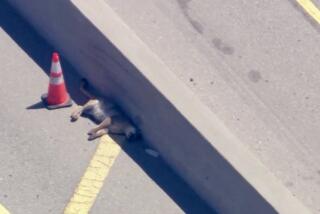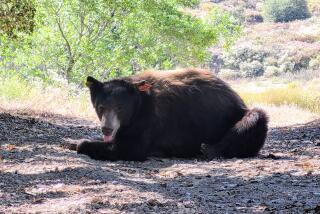Honk if You Love Answers to Your Questions
- Share via
Over the last decade, California has added more than 800 miles of carpool lanes to the state’s freeway system. And yet carpooling has declined in the Golden State and across the nation.
Ray Laforteza, a carpooler from Los Angeles, thinks he knows one reason why the so-called diamond lanes have lost their luster. He wrote to ask what he should do about maniac drivers who roar up behind him in the carpool lane and force him to exceed the speed limit.
Today, to launch a new monthly feature, Behind the Wheel will tackle questions from readers such as Laforteza. On the last Tuesday of each month, BTW will field queries, quibbles and questions about the state of roads and driving in California.
Question: When drivers are following too closely while you are in the carpool lane and they flash their lights, honk their horn or try to drive around you, is this right? I don’t think I have to squeeze myself into the slow lane just to let these crazy drivers pass because they want to drive 100 mph.
Answer: It may seem that people who carpool--thus saving gas and helping to reduce smog--are gentle, environmentally conscious folks. You know the sort--wearing hemp-knitted scarves and driving subcompact cars the size of a major kitchen appliance. Not so. When it comes to maneuvering Southern California’s congested freeways, carpoolers can be as obnoxious and lead-footed as the rest of us.
The behavior Ray describes is illegal. Speeding, following too close and improper use of the horn are all violations of the state vehicle code.
In a perfect world, a vigilant Highway Patrol officer would appear out of nowhere, arrest such miscreants on the spot and, say, force them to listen to 12 straight hours of Britney Spears. Serious violations call for serious penalties.
For you, the law-abiding carpooler, the best response is to remain under the speed limit and stay in the carpool lane until you can legally pull over and let the road hog pass.
Officer Connor MacIvor, a 12-year veteran of the Los Angeles Police Department, also advises that you not try to mete out freeway justice by slamming on your brakes or flashing a rude gesture. After all, you don’t know who is in the car behind you.
Even MacIvor, a barrel-chested, 6-foot-2-inch motorcycle officer with a distinctive shaved head, cautioned: “My Lord, I carry a .45 [handgun] wherever I go, but I would back down.”
Another target of disdain on Southern California freeways are the “looky-loos.” That’s a gentle euphemism for the knuckleheads who bring freeway traffic to a crawl so they can ogle minor fender-benders. It’s another violation that merits the Britney Spears sanction, with perhaps a little Celine Dion thrown in for good measure.
Heather Wall of Irvine wrote to Behind the Wheel with this suggestion for keeping traffic moving when there is an accident.
Q: Why can’t the CHP or Caltrans develop a quickly inflatable wall that could block the view of an accident from oncoming traffic?
A: Interesting idea. Knowing Caltrans, they might try to sell advertising on these inflated walls. Imagine this: “Burger King: Official sponsor of your San Diego Freeway accident barricades. Get off the 405 and grab a 99-cent Gridlock Grill Sandwich, with fries!” That alone should be reason enough to deflate the inflatable wall idea.
CHP Sgt. Tim Maley, a 25-year veteran who gave up a promising career as a comedian to become a cop, got a chuckle out of Heather’s idea.
“Inflatable wall,” he said. “That’s a good one.” Maley raised a few logistical questions: How many inflatable walls would be needed to serve the state’s massive freeway system? And who would be responsible for lugging them up and down the freeways?
Heather’s frustration is understandable. As it is, research shows we Southern Californians spend more time in traffic than we do on vacation. We don’t need a bunch of rubber-neckers adding to the gridlock.
But in the end, there is not much anyone can do about such behavior.
Maley and his colleagues at the CHP already have their hands full with road rage, police pursuits and crazed carpoolers. They don’t have time to worry about some slack-jawed commuter who slows down every time a fellow driver stops to jump-start a Yugo.
Speaking of stupidity on the road, Rich Keegan of Torrance wondered if there is any rational thinking behind the names of some of the state’s freeways. He wrote with this question:
Q: Why are some freeways that are identified as “interstate,” in fact, only in California? Highways like the I-405, I-105 and I-110, and a slew of others in San Francisco, go only relatively short distances--all within California.
A: Rich raises a good point.
While we’re at it, why is the 405 called the San Diego Freeway when, in fact, it extends south to Irvine, not San Diego?
And what about the 170 in the San Fernando Valley? It is called the Hollywood Freeway, but it merges with the 101 freeway about five miles short of Hollywood.
First, let’s deal with Rich’s question.
He points out correctly that some “interstate” freeways do not extend between two states. Still, the freeways earn the “interstate” title because they serve as alternate routes to interstate freeways that do join two or more states.
In the freeway system, there is an advantage to being dubbed an “interstate”--the federal government pays 90% of the construction cost, considerably more than it will pony up for a lowly state freeway.
Interstate 405 is considered an alternate to Interstate 5. Interstate 210 is an alternate to Interstate 10. The I-110 and the I-710 are not really alternates to any legitimate interstate freeway, but lawmakers in Washington granted them exemptions because the freeways serve the interstate transportation of goods from the ports of Los Angeles and Long Beach.
“They kind of stretched the definition on those,” said Chuck O’Connell, a former Caltrans deputy district director who has 40 years of experience building and managing freeways.
As for the Hollywood and the San Diego freeways, O’Connell said those names were adopted back in the days when motorists on those freeways were primarily destined for Hollywood and San Diego.
Ah, the good old days: When carpooling was safer than skydiving. When drivers weren’t so frustrated they dreamed of inflatable walls. And when an interstate did not take you from the state of disbelief to the state of despair.
*
Submit questions and comments to Behind the Wheel, c/o Los Angeles Times, 202 W. 1st Street, Los Angeles, CA 90012; or send an e-mail to [email protected].



